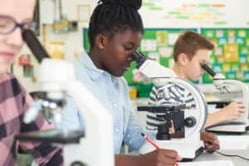Earth Science for Interactive Notebooks
I wanted to share with you how I use my earth sciences interactive notebook pages in my classroom. These pages make it so much easier for students to compartmentalize their learning and make sense of a topic that can be boring to many students.
Every Interactive Notebook is also available as a one-of-a-kind digital version! Enjoy easily editable PPTs and Google Slides, reflection pages for students to demonstrate their understanding, ample space for student notes, a teacher answer key, and a separate modified version for students with accommodations.
Continental Drift
I first teach about who Alfred Wegener was and about his contribution of the theory of continental drift. I use this skit as an engagement activity. The students have fun acting out the parts and it helps them to realize that Wegener had a lot of opposition. It also highlights the key pieces of evidence that he used to develop his theory.
Earth's Layers
I like to talk about the Earth's layers next. Without knowing about the 'engine' (mantle) of the Earth I think that it's hard to understand why the plates actually move. The notebook pages do a great job of illustrating the 4 main layers.
Tectonic Plates
Once I feel that we have a grasp on the layers of the Earth I then move into the tectonic plates. Even though my students are 8th graders I always review the 7 continents first. I'm always surprised that many of the students have forgotten the continent names. If they know those then the plate names are pretty easy for them. It's very important to distinguish the difference between the oceanic crust and the continental crust at this point. Many students (and adults) believe that it's the continents alone that move, which isn't true.
Plate Boundaries
Once the students have an understanding that the Earth's crust is broken into layers it is much easier to discuss the different types of plate boundaries. There are several foldables and a matrix that I use to help students learn the difference between convergent, divergent and transform. Here's a bonus for you!
Sing the song to the tune of the Adams Family theme song
Convergent is colliding
Divergent is dividing
Transform is sliding
We are the plate boundaries.
duh-na-na-na <snap><snap>
duh-na-na-na <snap><snap>
duh-na-na-na duh-na-na-na duh-na-na-na
<snap><snap>
Rocks and Minerals
The next topic that I usually cover is rocks and minerals. I like to start with the Venn diagram of rocks vs. minerals before hitting on the properties of minerals. This is a great time to bring back in the topic of density. One of my favorite labs is the minerals station lab that we do in 6th grade. The students love getting their hands on the minerals.
Rock Cycle
The rock cycle is about as dry as it gets from a middle school perspective, but I actually love this unit. Again, there are a lot of fun labs that you can do including the rock cycle crayon lab. The flip book has a spot for distinguishing igneous, sedimentary, and metamorphic rocks underneath the rock cycle diagram.
Topographic Maps
This year was the first year I taught topographic maps and I really enjoyed it. It's such a practical thing that students can relate to. We had a lot of fun pretending we were in the military and were planning strategic attacks on certain points of the map. The students got really creative with how they were going to attack certain positions based on elevation. The flip book has a fictitious map of an area and then asks questions based on certain points of the map. There is also a map showing the same mountain over a 150 year period. The students are supposed to deduct that the mountain has changed due to erosion.
Download Over $100 in FREE Resources
For Middle School Science
Simply create a login below and gain immediate access to a selection of our Kesler Science product line worth $100 - for FREE. There's a full version of every product type! You'll also join tens of thousands of middle school science teachers who receive timely tips and strategies straight to their inbox.




